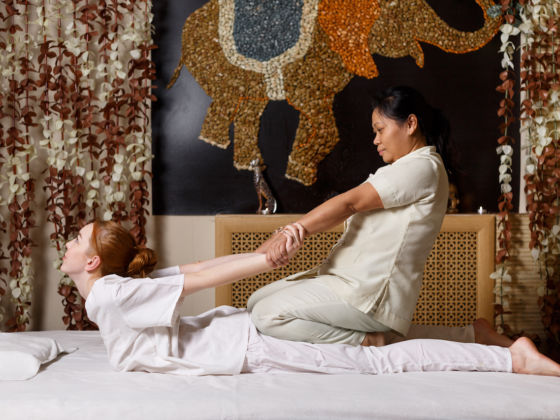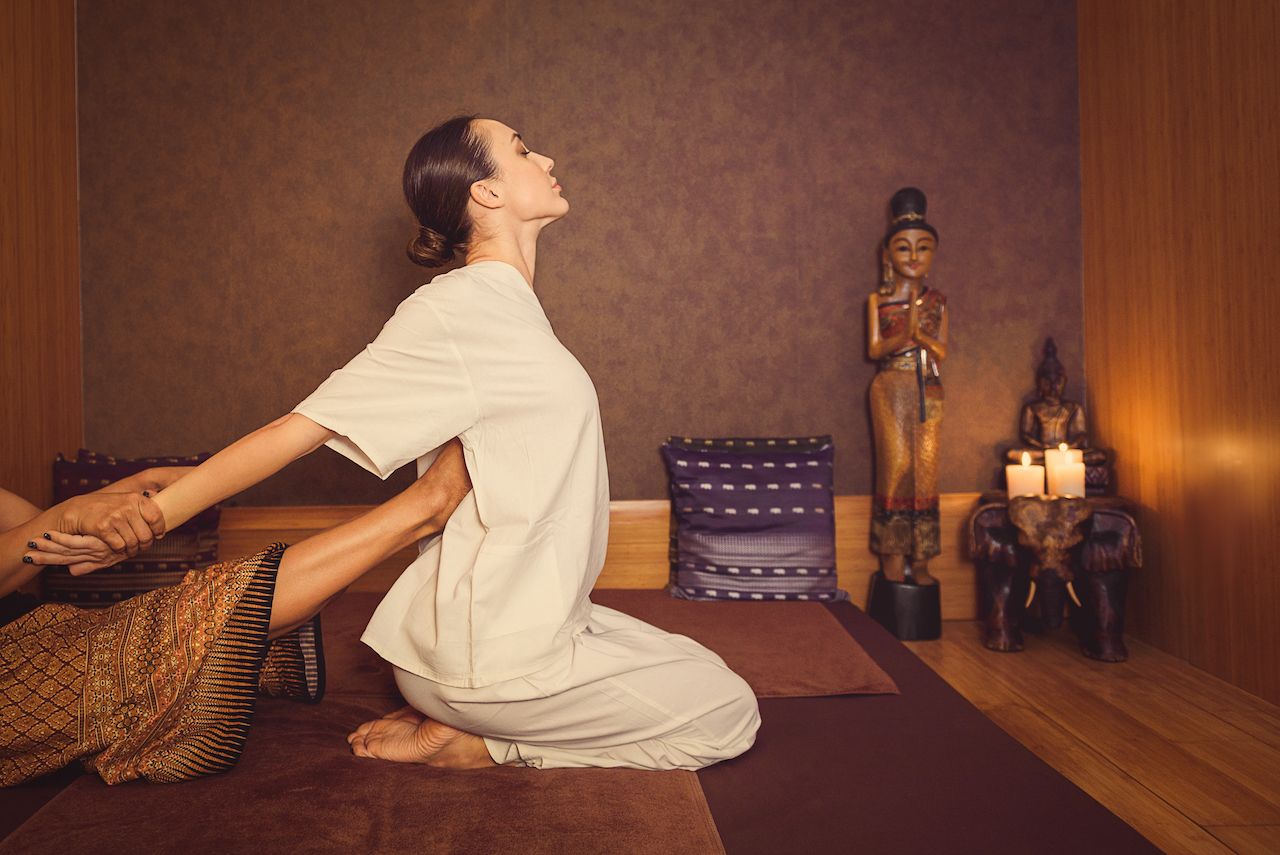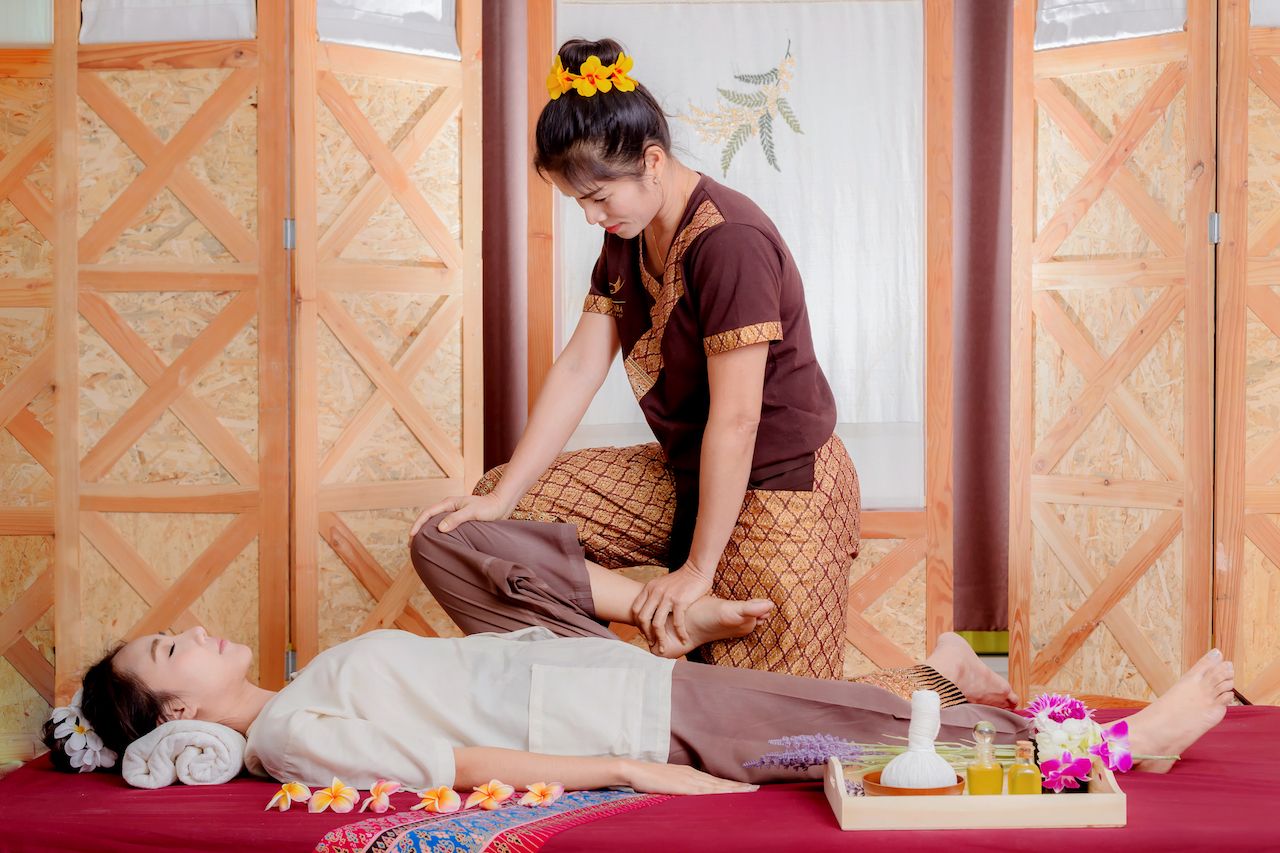For first-time spa patrons, getting a massage can be intimidating and raise questions like Is this going to hurt? Tickle? Do I keep my underwear on or go buff? But even for those familiar with a deep-tissue massage or a Turkish bath pounding, a Thai massage is something completely different, more like assisted yoga mixed with acupressure. Once you try it yourself, you’ll understand why it’s arguably the most approachable of the types of massages. Here’s everything you need to know before your first Thai massage.


Everything You Need to Know Before Your First Thai Massage
The origins of Thai massage
The history of nuad boran, or “ancient healing touch,” is older than Thailand, dating back to ancient India, Ayurvedic medicine, and the origins of Buddhism. Ayurveda, the ancient Indian “science of life,” teaches that our bodies possess unique combinations of the three doshas (life energies) which need to be in balance. The path to harmony lies in herbs, nutrition, spiritual meditation, and a special form of massage that focuses on the body’s energy pathways, or sens in Thai. Sometime during the fifth century BCE, Jivaka, a respected doctor and Ayurvedic healer, met the Buddha and became both a follower and his doctor. He also built a monastery. Jivaka’s medical knowledge was passed down through generations of Buddhist monks and their temples, known as wats in Thai. As Buddhism spread from India to what is now modern Thailand, this healing knowledge spread as well, and Jivaka became known as the father of Thai traditional medicine.
Certain Thai temples still double as massage parlors. But if you do venture out to one of the many private salons, don’t worry about fly-by-night operations: Thai massage is regulated by Thailand’s Ministry of Public Health. All practitioners must take an approved training course and pass a national examination to be licensed. In addition to the actual physical methods, a typical month-long course covers physiology, anatomy, and traditional medicine.
What to expect at a Thai massage

Photo: Olena Yakobchuk/Shutterstock
First things first: There’s no massage table. Thai massages are done on a padded mat or thin mattress laid out on the floor. In a temple setting, this may be in a large open salon while in spas you’ll have either a private room or a curtained-off space. You don’t need to lose your knickers, as your therapist presents you with a neatly folded set of one-size-fits-all pajamas. You want your clothes to be loose.
There are no oils or lotions. The therapist uses their entire body to stretch and compress muscles and joints and to apply acupressure to specific points along the body’s yogic energy lines. Don’t be surprised if a masseuse places a foot in your armpit as they pull on your arm to stretch a shoulder muscle, or if they place their knees in your back (always gently) to pull you into a yoga pose to stretch your abs. You can expect a lot of physical contact, and sometimes the stretching may amusingly resemble wrestling.
Thumbs, knuckles, feet, and elbows push at pressure points to encourage energy flows. Admittedly, some may find this uncomfortable. However, I’ve had these treatments many times over the years, and in every case, the therapist has consistently asked if I’m OK and if I prefer softer pressure. Often, the therapist is so in tune with my breathing or tension that she or he can sense my limits.
Typical treatments last one or two hours, and, thanks to government regulation, you’re likely to get very similar treatments at a luxury spa, sidewalk salon, or the floor of a Buddhist temple. Luxury spas may add an extra flourish or combine Thai methods with aromatherapy as a hybrid treatment, so be sure to ask what exactly you are getting.
Why you should get a Thai massage

Photo: Piriya Kulvatada/Shutterstock
Massages are very relaxing, especially when you have jet lag. It’s not like aromatherapy where there’s a chance you fall asleep, though. While they are relaxing, you’re engaged almost as if the therapist is leading you in a dance. If you are not already sold on the health values of yoga, Thai massage may convince you. After a treatment, you can expect to be loose and energized, with your muscles warm and stretched. The stretches can give relief to sore muscles and joints while preventing injuries related to tightness and inflexibility. These physical benefits translate to mental ones, with better focus and maybe even a positive attitude adjustment.
Best places for a Thai massage in Bangkok and Chaing Mai
Local massage parlors are as ubiquitous as 7-Elevens in Thailand, and some of them will have a collection of young women sitting out front calling to passersby. I’ve been to some of those and they’ve been fine, but there are better experiences. I advise starting with a temple experience. These aren’t spas, so don’t expect lavender essential oil vaporizers and New Age meditation music on a loop, but the Thai massage treatments are reliably good and traditional.
Wat Pho Massage in Bangkok: Prices for a Thai massage here may be a couple of dollars more than the average mom and pop shop, but these masseuses are fresh out of training. As a bonus, you’re visiting one of Bangkok’s most famous temples, and you can travel the Chao Phraya River to get here.
Address: 2 Sanam Chai Rd, Khwaeng Phra Borom Maha Ratchawang, Khet Phra Nakhon, Krung Thep Maha Nakhon 10200, Thailand (13.746695, 100.493943)
Wat Worachanyawas in Bangkok: Not a popular temple for visiting as it’s overshadowed by Wat Yanawa up the street, but a couple of spa managers I know tell me their own massage therapists go here for their Thai massages. The temple is right on the Chao Phraya River, and the treatments are done under open-air pavilions with ceiling fans. It’s one of the cheapest prices you’ll find, with a massage running somewhere in the neighborhood of $5-6.
Address: 10120 25/2010 Charoen Krung Rd, Khwaeng Wat Phraya Krai, Khet Bang Kho Laem, Krung Thep Maha Nakhon 10120, Thailand (13.7090477,100.5076675)
Nuch Massage in Bangkok: Most popular for foot massage, Nuch (sounds like “noodt”) is often full of visitors side by side in recliners with their feet up. Upstairs, you’ll find two floors with several Thai massage mats sectioned off by curtains. There’s a punch card for repeat visitors if you think you’ll be around for 10 treatments. It’s conveniently located just steps from the Phrom Phong BTS station.
Address: 1, 8 Sukhumvit Rd, Khwaeng Khlong Tan, Khet Khlong Toei, Krung Thep Maha Nakhon 10110, Thailand (13.729784, 100.569526)
Wat Si Koet in Chiang Mai: If you go to Chiang Mai, this is the temple massage to go to in the Old City. Mats are in an open-air salon with fans. It’s not unusual to be the only person there, but don’t worry it’s legit, excellent, and quite cheap.
Address: Rachadamnoen Rd, Phra Sing, Amphoe Mueang Chiang Mai, Chang Wat Chiang Mai 50200, Thailand (18.788264, 98.983987)